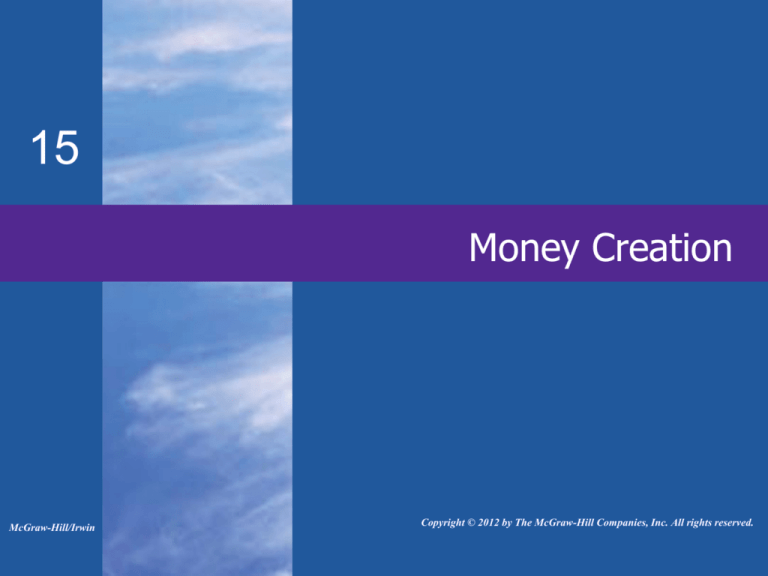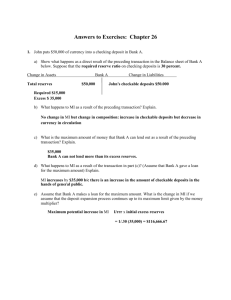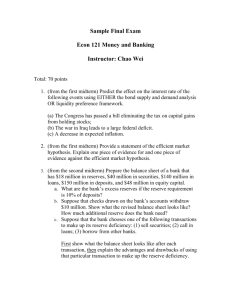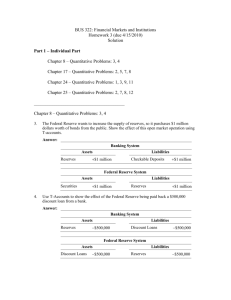
15
Money Creation
McGraw-Hill/Irwin
Copyright © 2012 by The McGraw-Hill Companies, Inc. All rights reserved.
Fractional Reserve System
• Balance sheet
• Assets = Liabilities + Net Worth
• Both sides balance
• Necessary transactions
• Create a bank
• Accept deposits
• Lend excess reserves
LO1
15-2
A Single Commercial Bank
Transaction #1
Vault cash: cash held by the bank
Creating a Bank
Balance Sheet 1: Wahoo Bank
Assets
Cash
LO1
Liabilities and Net Worth
$250,000 Stock Shares
$250,000
15-3
A Single Commercial Bank
Transaction #2
Acquiring property and equipment
Acquiring Property and Equipment
Balance Sheet 2: Wahoo Bank
Assets
Cash
Property
LO1
Liabilities and Net Worth
$10,000 Stock Shares
240,000
$250,000
15-4
A Single Commercial Bank
Transaction #3
Commercial bank functions
• Accepting deposits
• Making loans
Accepting Deposits
Balance Sheet 3: Wahoo Bank
Assets
Cash
Property
LO1
Liabilities and Net Worth
$110,000
240,000
Checkable
Deposits
Stock Shares
$100,000
250,000
15-5
A Single Commercial Bank
Transaction #4
Depositing reserves in a Federal
Reserve bank
• Required reserves
• Reserve ratio
Reserve
ratio
LO2
=
Commercial bank’s
Required reserves
Commercial bank’s
Checkable-deposit liabilities
15-6
A Single Commercial Bank
Type of Deposit
Current
Requirement
Statutory
Limits
Checkable deposits:
$0-$10.7 Million
$10.7-$55.2 Million
Over $55.2 Million
Noncheckable nonpersonal
savings and time deposits
0%
3
10
3%
3
8-14
0
0-9
• The Fed can establish and vary the reserve
•
LO2
ratio within limits set by Congress
Required reserves help the Fed control
lending abilities of commercial banks
15-7
A Single Commercial Bank
Transaction #4
Assume the bank deposits all cash
on reserve at the Fed
Depositing Reserves at the Fed
Balance Sheet 4: Wahoo Bank
Assets
LO2
Liabilities and Net Worth
Cash
Reserves
$0 Checkable
110,000
Deposits
Property
240,000 Stock Shares
$100,000
250,000
15-8
A Single Commercial Bank
• Excess reserves
• Actual reserves - required reserves
• Required reserves
• Checkable deposits x reserve ratio
• Example:
• Checkable deposits $100,000
• Reserve ratio 20%
LO2
15-9
A Single Commercial Bank
•
Transaction #5
Clearing a check
$50,000 check reduces reserves
and checkable deposits
Clearing a Check
Balance Sheet 5: Wahoo Bank
Assets
Reserves
Property
LO2
Liabilities and Net Worth
Checkable
$60,000
Deposits
240,000 Stock Shares
$50,000
250,000
15-10
Money Creating Transactions
Transaction #6a
Granting a loan
• $50,000 loan deposited to checking
When a Loan is Negotiated
Balance Sheet 6a: Wahoo Bank
Assets
Reserves
Loans
Property
LO3
Liabilities and Net Worth
$60,000 Checkable
Deposits
50,000
240,000 Stock Shares
$100,000
250,000
15-11
Money Creating Transactions
•
Transaction #6b
Using the loan
$50,000 loan cashed
After a Check is Drawn on the Loan
Balance Sheet 6b: Wahoo Bank
Assets
Reserves
Loans
Property
Liabilities and Net Worth
$10,000 Checkable
Deposits
50,000
$50,000
240,000 Stock Shares
250,000
A single bank can only lend an amount
equal to its preloan excess reserves
LO3
15-12
Money Creating Transactions
•
Transaction #7
Bank buys government securities
from a dealer
Deposits payment into checking
Buying Government Securities
Balance Sheet 7: Wahoo Bank
Assets
Reserves
Securities
Property
Liabilities and Net Worth
$60,000 Checkable
Deposits
50,000
240,000 Stock Shares
$100,000
250,000
• New money is created
LO3
15-13
Profits, Liquidity, and the Fed Funds Market
• Conflicting goals
• Earn profit
• Make loans to earn interest
• Buy securities to earn interest
• Maintain liquidity
• Alternative?
• Overnight bank loans
• Federal funds rate
LO3
15-14
The Banking System
• Multiple-deposit expansion
• Assumptions:
• 20% required reserves
• All banks “loaned up”
• Banks lend all of their excess
•
•
LO4
reserves
A $100 bill is found and deposited
Multiple deposits can be created
15-15
The Banking System
(3)
Excess
Reserves
(1)-(2)
(1)
Acquired
Reserves
and Deposits
(2)
Required
Reserves
Bank A
$100
$20
$80
$80
Bank B
$80
$16
$64
$64
Bank C
$64
$12.80
$51.20
$51.20
Bank D
$51.20
$10.24
$40.96
$40.96
Bank
(4)
Amount Bank Can
Lend; New Money
Created = (3)
The process will continue…
LO4
15-16
The Banking System
Bank
(1)
Acquired
Reserves
and Deposits
Bank A
$100.00
Bank B
80.00
Bank C
64.00
Bank D
51.20
Bank E
40.96
Bank F
32.77
Bank G
26.21
Bank H
20.97
Bank I
16.78
Bank J
13.42
Bank K
10.74
Bank L
8.59
Bank M
6.87
Bank N
5.50
Other Banks
21.99
LO4
(2)
Required
Reserves
(Reserve
Ratio = .2)
(3)
Excess
Reserves
(1)-(2)
$20.00
16.00
12.80
10.24
8.19
6.55
5.24
4.20
3.36
2.68
2.15
1.72
1.37
1.10
4.40
$80.00
64.00
51.20
40.96
32.77
26.21
20.97
16.78
13.42
10.74
8.59
6.87
5.50
4.40
17.59
(4)
Amount Bank Can
Lend; New Money
Created = (3)
$80.00
64.00
51.20
40.96
32.77
26.21
20.97
16.78
13.42
10.74
8.59
6.87
5.50
4.40
17.59
$400.00
15-17
The Monetary Multiplier
Monetary
multiplier
LO5
=
1
required reserve ratio
=
1
R
15-18
The Monetary Multiplier
• Maximum amount of new money
•
•
LO5
created by a single dollar of excess
reserves
Higher R, lower m
Reversibility
• Making loans creates money
• Loan repayment destroys money
15-19
Bank Panics of 1930-1933
• Before deposit insurance
• Bank failure led to mass withdrawals
• Forced loan reduction
• 25-33% decline in money supply
• 1933 national bank holiday to evaluate
•
•
all banks
Contributed to the Great Depression
Regulation protects the system today
15-20










